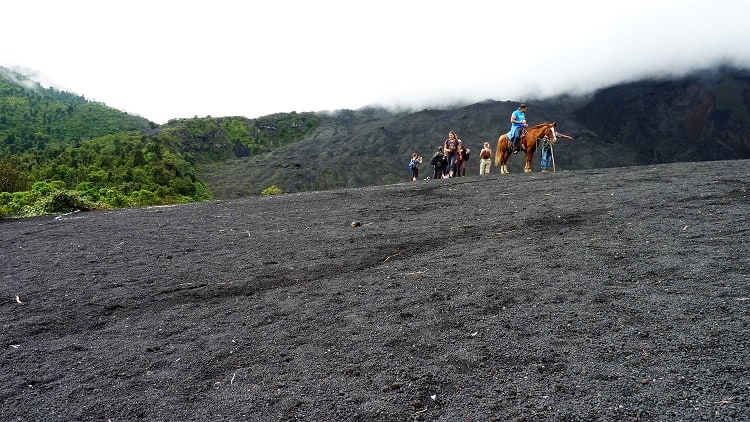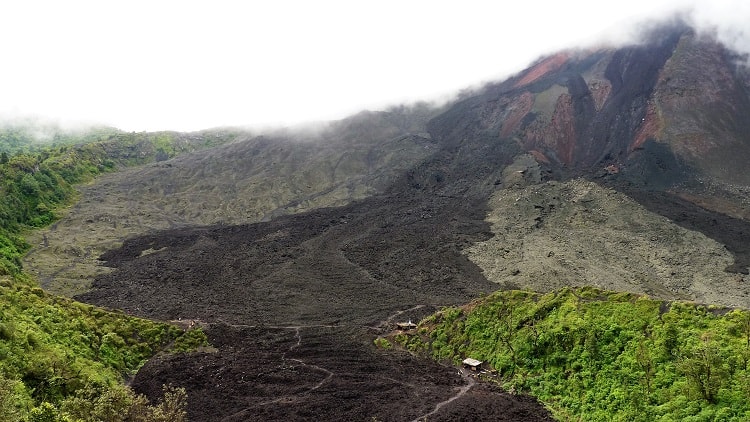Last Updated on March 3, 2025 by Ellen
We retired early to enjoy a budget travel lifestyle with exploration and adventure. And so, I hiked my first volcano – an active volcano – Volcan de Pacaya in Guatemala with my husband. Not bad for a woman who’s almost 46.
I was by far the oldest woman in the group. In fact, most of the girls were so young they could have been my children. It’s not too difficult to pick me out of our group in the photo below.

My husband, at age 53, was the oldest man there – and likely the oldest person there. Some young people didn’t even hike up – they rode horses up the trail!
Why am I so focused on age? Maybe it’s because I’m experiencing perimenopause and I’m acutely aware of my so-called biological clock ticking faster, as if I’m about to hit some kind of deadline, some kind of finish line on youth. Or maybe it’s because I want to show myself that age is just a number, since my age keeps getting higher. Or maybe it’s because my husband jokingly declared once we were at the top, “The old people made it!”
I know focusing on age is ridiculous. I know a few people in much better shape than me who are much older. Whatever the reason my age is top of mind, the reality is this: anyone in relative fitness at any age can do this hike.
It’s described by the park as moderate, and I’d agree with that assessment, as a former smoker of 25 years hiking in high altitudes. The trail itself is pretty easy, and my spouse had zero issues with the altitude. It took our group about an hour and a half to go a mile and half up, with three rest breaks of a couple minutes each. Our guide told us it was about 7k round trip, with an elevation gain of about 1,000 feet. The trail is well-maintained and the forest scenery is gorgeous.
As I mentioned, several people used horses on the trail to get the top. I asked one guy how much it cost, he said about $14 each way, up and down. As you start out on the trail, the locals look at you, point to their horses, and say, “Taxi?” No gracias. Not for this one.

The steepest part was from the second rest stop until the third rest stop. The third stop is the highest point the guides let us go for safety reasons.
Between stops two and three, I broke a big sweat, was huffing and puffing, and eventually asked my husband to carry our backpack for the last 5 percent of the hike up. The elevation seemed to make me gasp for more air. I definitely noticed the higher altitude because the air was a bit thinner.
It’s about 8,300 feet to the summit, but we didn’t go to the crater. We got to about 7,500 feet at the third major rest area, according to my iPhone compass. This area is a patch of level ground, a platform of sorts, on which to view Pacaya.

You cannot hike onto the rim because this is an active volcano. And since we went during rainy season, we never even saw the rim – it was covered by clouds. Yet we were lucky to see the beautiful scenery not covered by clouds.
There are other things to explore beside watching smoke belch out from the rim, like the lava field and dried-up, prickly lava balls.

After the hike up, we hiked down into the lava field. The view is incredible. We walked down on the volcano face scorched in years past by hot molten earth.
The last major eruption was in 2014, but the rocks underneath the dried out surface still hold heat! When we were there three years later, some areas were steaming. It had a majestic, other-world quality.

Some spots were hot enough to roast marshmallows. Our guides brought a bag of them with sticks so our group members could have a sweet treat but I fed my marshmallow to a dog. Yes, a dog. Hey – this is Central America, and stray dogs are everywhere, even on lava fields of a volcano.

Many rocks were surprisingly sharp, and porous. If you reached down underneath the top layer of dried lava balls, you’d feel rocks warm to the touch – sometimes they were almost downright hot!
The inside of the rocks look like they’re wet, but they are not. It’s fascinating to hold these warm, sharp, dried lava balls and imagine where the stuff comes from – what’s in the center of Earth that gets spewed out onto her surface.

The heat was incredible.
After some time in the field, it was time to climb back up to the platform area to get the trail for the return down the volcano. On the way, we walked by a small store in the lava field selling trinkets made by local people. It’s basically a tin roof held up by poles, to protect goods for sale. (You can see the structure in a picture above.)
There are two paths up and down Pacaya, and our group took the easier route. Apparently, the alternative way gets too slippery and takes much longer than 1.5 hours in the rainy season. We were lucky – it only rained a few drops on us as we walked down. And as soon as we got back inside the tour van, it started to pour. It was raining so hard rivers of water rushed by our van on the roadway.
We knew when we came to Antigua in June that it would be wet often. That’s our main concern about hiking the much more challenging Acatenango volcano. People hike Acatenango in order to look down on its active twin – Fuego. Acatenango is huge compared to Pacaya – it’s nearly 13,000 feet. That hike is a 5,000 foot elevation gain. Acatenango is an overnight hike, and it rains every night – sometimes just for a couple of hours, but often it pours all night. Most mornings the rain clears out with the sunrise – and that’s why you overnight hike Acatenango: sunrise against the lava show with stars still shining is undoubtedly on unforgettable experience on this planet. I’m leaning towards trying this other hike, but stay tuned.
We arranged our Pacaya excursion through the La Union School for Spanish. Transportation was $10 USD each, admission was $7 USD each, plus tips, and $1.30 USD for walking sticks. I was glad I had a walking stick for when we went down into the lava field. It was slippery because of loose rocks. We got ours as soon as we exited the tour van. Kids ran up to us trying to make a deal.
We have seen much higher prices advertised at tour companies around Antigua, so we felt a total of about $40 for two people was a great deal for great memories of us ‘old people’ hiking an active volcano.

And, I’ll end by pointing out, all of the young people in our group zonked out during the hour-long ride back to Antigua, while yours truly was wide awake.

🙂
This volcano hike was much more difficult – overnight up Acatenango.
This park hike was much easier – hike up to the clouds near Antigua.


you are the energizer bunny in disguise, right? **waves hi from Ottawa**
Lol! Not really. I go to bed by 11. Hugs from Guatemala!